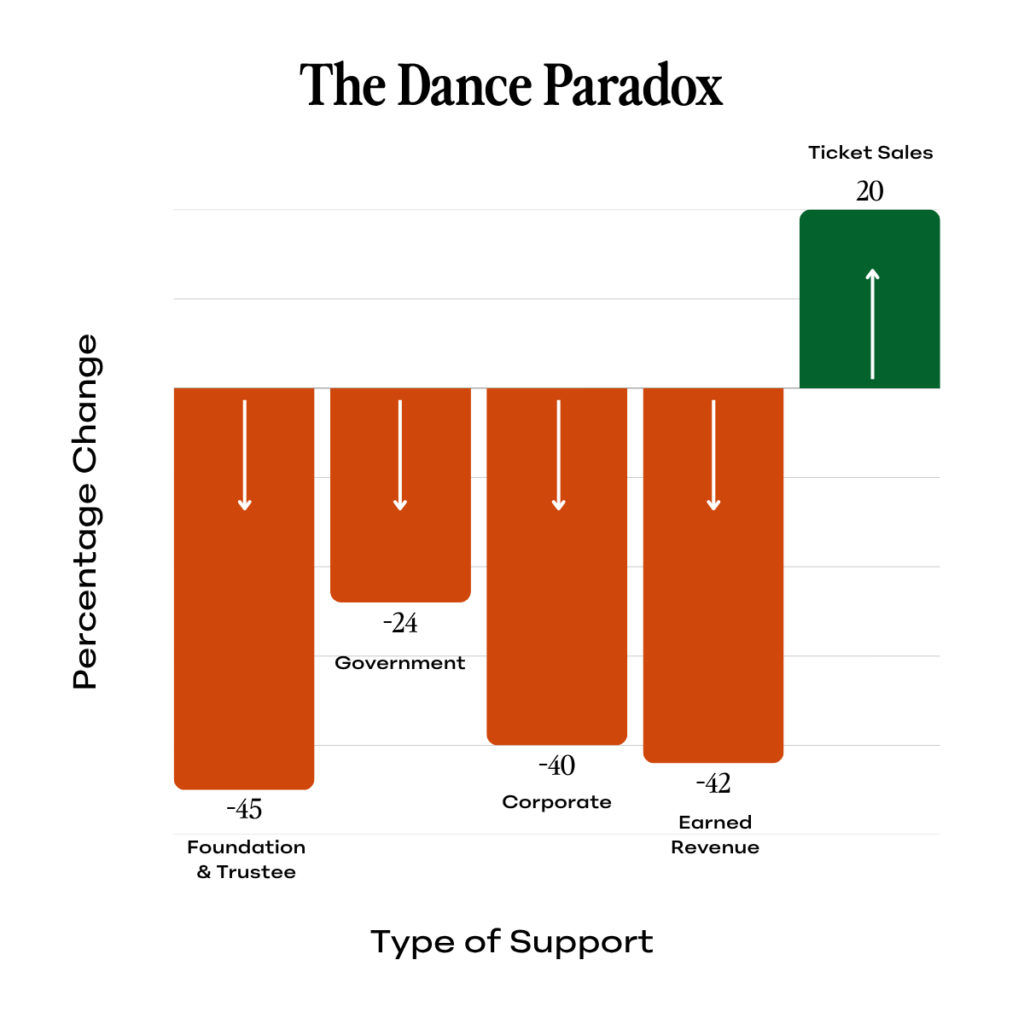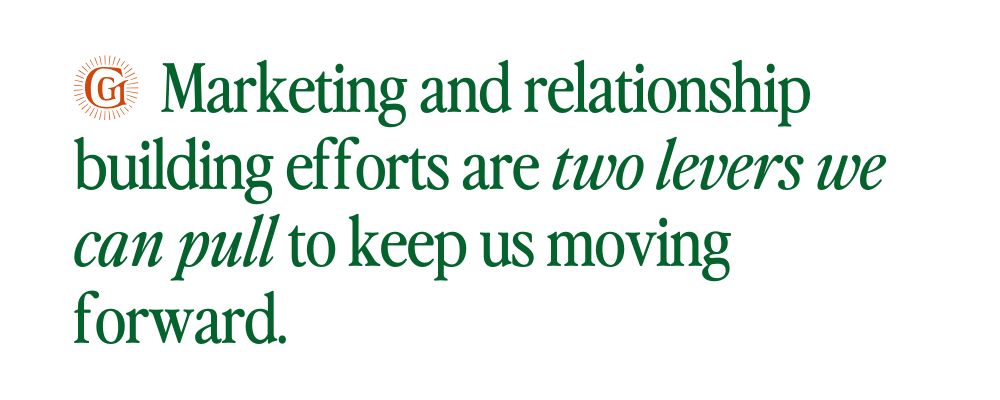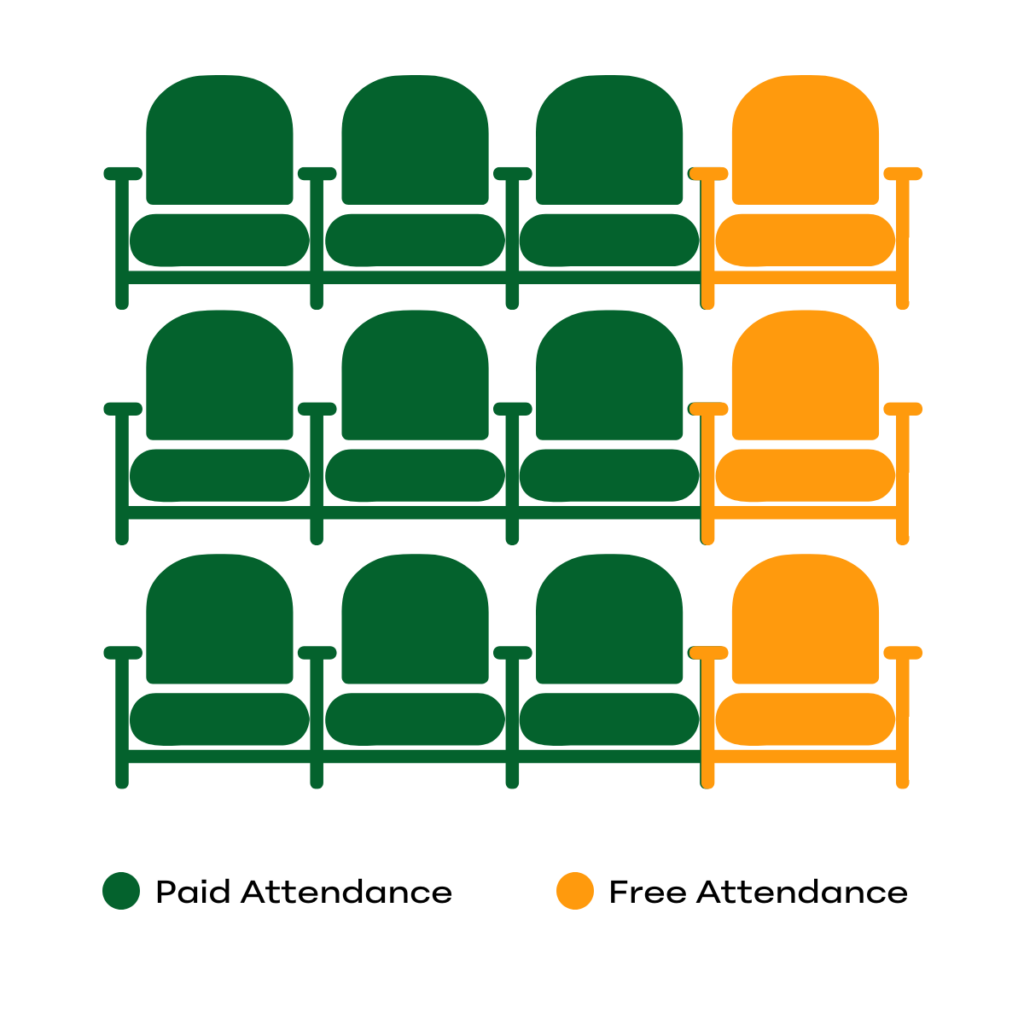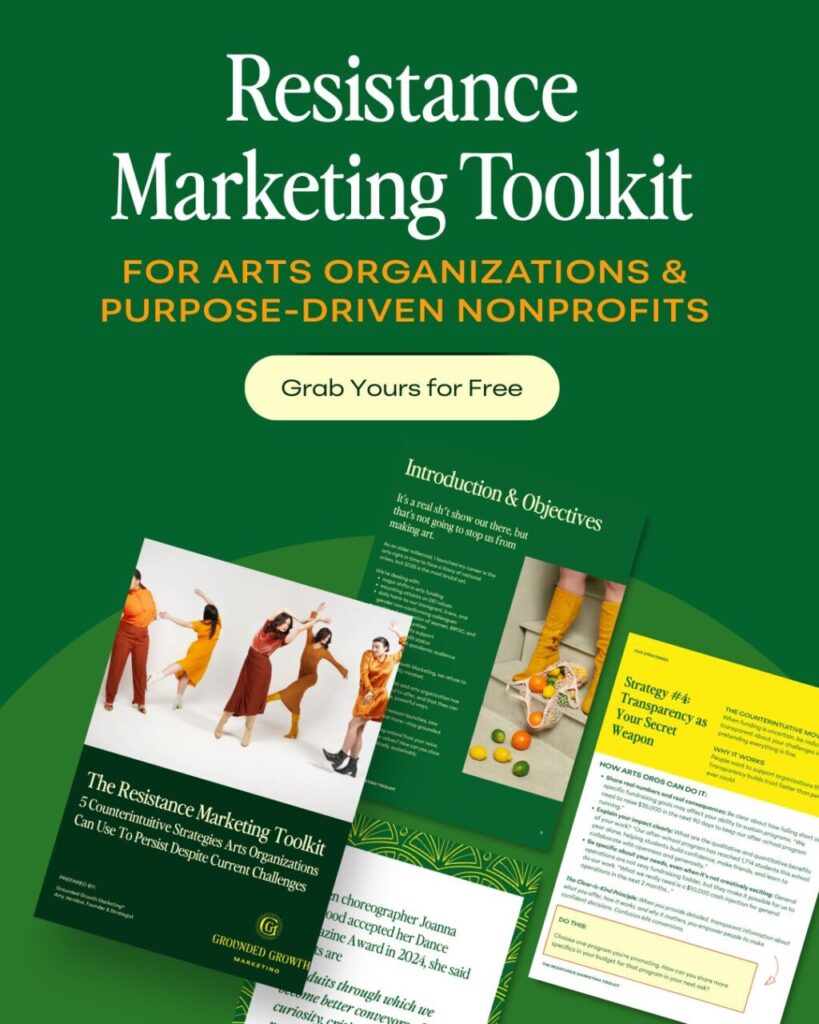For Dance: Revenue is Falling But Attendance Is Up (What Does This Mean, and What Do We Do About It?)

Sponsored Content from Amy Jacobus & Grounded Growth Marketing
Our Grounded Growth Marketing team recently attended several presentations from SMU Data Arts and Dance/USA where researchers presented findings on revenue, expenses, capacity, audience trends, and more, based on data from 6,500+ arts organizations nationwide.¹
The numbers across the broader arts industry are sobering. From 2023-2024:
- Contributed revenue fell 30%, with every single source declining simultaneously
- Foundation funding dropped 25%
- Government funding declined 26%
- Earned revenue declined 18%
- Personnel costs were slashed by 23%
According to Dance/USA, the dance sector has been hit even harder.² From 2019-2022, dance organizations specifically have experienced:
- Earned revenue down 42% overall—yet ticket sales specifically grew 20%, indicating strategic audience loyalty around programming choices
- Foundation and trustee support dropped 45%
- Government support down 24% nationally; corporate giving down 40%
- Workforce reductions continue, especially among independent contractors, though some orgs are shifting to part-time roles to save on benefits
- Many orgs are operating without endowments entirely (one-third), and among those that do have endowments, most funds are restricted or inaccessible for operational use

These numbers don’t yet reflect the true horror show of 2025—the realities of funding clawbacks, job loss, rising prices, attacks on our very values as a sector, and the real fears artists face in touring and leading their work related to threats based on identity, immigration status, politics, or character.
Yet, we persist. Data shows that organizations across the arts sector served MORE people in 2024 than they did in 2019. Paid and free attendance have both grown significantly, surpassing pre-pandemic levels.
We are anxious and uncertain, and still, we create.
The arts are reaching more people, yes, BUT we have less resources powering the creation and production of that work. We’re cutting staff and watching contributed revenue evaporate before our eyes.
Those of us familiar with the burnout and churn rate inside nonprofit organizations understand that this math doesn’t work. And with the state of foundational and governmental support for the dance sector right now, we won’t be able to simply grant-application our way out of this.
So what can we do? When it feels like there is so much we cannot control, our marketing and relationship building efforts are two levers we can pull to keep us moving forward.

What the Numbers Tell Us (and What They Mean for Dance)
The reality is stark: nearly half of arts organizations are running deficits, working capital has eroded dramatically, and revenue declines have outpaced expense cuts across every single source of contributed revenue—from foundations, individual donors, corporations, and government.
But there’s hope: earned revenue is declining much more slowly than contributed revenue. For dance organizations specifically, ticket sales are actually growing even as overall earned revenue wavers.
If contributed revenue (grants and donations) is increasingly unreliable, earned revenue (tickets, classes, workshops) will need to be relatively more stable.
Dance companies will need to be both pragmatic and imaginative as they navigate an environment marked by unstable funding, inflationary pressure, and unpredictable audience behavior.
If you’re a dance artist or dance organization, this means marketing for ticket sales, class enrollment, and workshop registrations isn’t a nice-to-have. It’s essential infrastructure.

Marketing to Acquire New Audiences (or: Why Collaboration is Central to Growing your Audience)
The arts sector is doing something right if participation is up for both paid and free events. But if you’re feeling stuck growing an audience, holistic thinking and smart marketing can help you do so.
First, assess: if your programs are generating likes and clicks, but no one is signing up, can you dig deeper to understand WHY? Limited engagement to limited purchases is a numbers game that makes sense, but plenty of engagements and still limited purchases could signal a need to reassess your programming.
GGM has a client that is currently receiving hundreds of click-throughs (tracked on web and email) by a right-fit audience to their programs on offer; but only 1-2 registrations per event. To our team, this signals a few potential issues:
- There’s a problem with market fit. Something (date, time, price, etc.) doesn’t work for our intended audience.
- There’s a problem with the value proposition. We aren’t doing a good enough job educating our audience on the benefits and outcomes of these events to make it worth their investment.
Consider your overall messaging
Many of GGM’s dance clients are multi-hyphenates: choreographers and educators, organizations that offer community programming and put on performances. These separate and distinct services or goals can make it challenging to be consistent as you communicate with the public.
Don’t chase after increased visibility only for the sake of of higher social media views; make sure you are attracting attention from the right people. (Awareness only matters if it leads to engagement and action.)
To refine how you show up, and grow an audience that will invest in your full mission, start with WHY you do what you do and WHO it’s for, instead of WHAT you do:
- Are there philosophies, beliefs, values that support every service or segment of your work?
- Do the same, or different, types of people engage with each facet of your work? If different, what might they have in common?
- What’s the most important thing you want to be known for right now? (And what are you known for currently?)
Knowing the answers to these questions can help you craft messaging that builds greater awareness and understanding of your work in the world.
Always work collaboratively
Our team often hears from independent dance artists that larger organizations do not provide the kind of support and expanded capacity they were expecting when given teaching, residency or performance opportunities.
We understand the frustration, and we also see and empathize with what’s happening on the organization-side.
Bigger organizations may have a staff dedicated to marketing efforts (not always, though, you’d be surprised), unlike most individual artists, but these organizations, too, are losing support. According to SMU Data Arts’ research, the entire arts sector is trying to protect artist payments. Data shows folks are cutting artist fees (11%) less than they are cutting staff costs (23%). But those staff cuts drastically impact how much support an organization can provide the artists! When a $200,000 organization loses a $40,000 NEA grant, that’s capacity gone. And when a stretched-thin, three-person marketing team becomes a completely-overwhelmed, two-person marketing team, that is felt through all relationships.
This is why we need to work with each other to:
- Craft longer project timelines, with early discussions of marketing strategy between presenter and artist
- Commit to both artist and organization sharing promotional materials leading up to the engagement and having clear expectations for what that means
- Sharing assets and some of the labor of that promotion — artists often assume presenters have more capacity and we know that’s not always the case; presenters assume artists will have professional quality media related to their work, and again, we know that’s not always the case
Both artists and organizations need to come together in understanding and shared responsibility for this work, because when we tap into other’s networks, we can grow our own. A festival’s audience grows with the introduction of fans of a new artist they’re presenting; the artist’s audience grows, too, when festival ticket buyers are introduced to and enjoy their work. If everyone wins, everyone should make it a priority to work together, equitably and with grace and understanding.
Remember also: funders and past partners can help uplift a work; ticket buyers or participants of past, related works can help spread the word; collaborating artists in production design, dramaturgy, curriculum design, and more can also uplift the next engagement.
Remember as you grow
Build your own email list. Whether you’re an organization or a solo artist. Everyone who takes a class, attends a showing, or collaborates with you—capture their email (with permission). Artists, ask presenting organizations to invite their ticket buyers to subscribe to your list as well. You need to own your audience relationships, not just rent them from Instagram.
Diversify your income streams. Classes, workshops, digital content, commissions, teaching, cash bars at events… Where can you most easefully add one more revenue stream? Take what you’re already doing well and consider how you might monetize it.
Mine your feedback. Ask students what they’re learning from you. Ask audience members what they love about the work. Ask donors why they care. Share those testimonials. It builds trust and demonstrates real impact and relationships.

The Attendance Paradox (or: Why You Need Better Systems to Nurture Existing Audiences)
What feels particularly sticky right now is that the arts sector is bringing more people into our world than ever before, but almost a quarter of that attendance is free.
People are showing up. But if you’re not capturing and building intentional relationships with those free attendees, you lose out on future opportunities for ticket purchases, donations, and advocacy of your work.
If you’re also dealing with staff reductions, you can’t do this as a last-minute fire drill. You need systems.
Email segmentation isn’t optional anymore
GGM wrote about email segmentation earlier this year, and I’m going to keep banging this drum because it matters more than ever.
Stop emailing everyone about everything.
When someone attends a free community class, they require a different messaging journey than someone who bought a $75 ticket to your mainstage show. When someone lives 2,000 miles away, they don’t need five emails about your local workshop.
Segmented emails get higher engagement, lower unsubscribe rates, and better conversions. In a world where arts funding is under scrutiny and every supporter matters, you can’t afford to annoy people with irrelevant content.
Categorize your subscribers by interest or past activity with your organization, look at how they’re interacting with other campaigns, and make sure you segment by location when relevant.
[For more on how to segment by interest, campaign interaction, and engagement level, our team put together a free resource called The Resistance Marketing Toolkit with five counterintuitive strategies for arts organizations. Strategy #2 is all about segmentation, and it includes specific how-tos you can implement immediately.]
A call for content strategy to deepen your relationships
It’s 5x more expensive to acquire a new audience member than to retain an existing one, and the average total value of a renewed member is 35.7% more than that of the average total value of a newly acquired member.³ Lifetime audience member value dictates that we should invest more time in nurturing existing relationships than reaching and converting new-to-use members.
Instead of increasing the volume of sales promotions for upcoming seasons and events, increase your storytelling and create space for your community to engage more deeply.
When your audience feels seen and cared for, they’ll keep showing up. Not only that, they’ll become better advocates, helping you with the growth arm of your marketing. Satisfied audiences share your work, defend your value, and recruit new supporters—naturally and reliably.
What this looks like:
- Share artist voices, not just polished trailers: in addition to showing the work, introduce the ideas and processes of the choreographers and makers behind it
- Show behind-the-scenes process: show glimpses into rehearsal, backstage views, archive footage, and more
- Start conversations: instead of “Buy tickets now,” try “Which of our past performances moved you most, and why?” or “What are you most looking forward to this season?” (Reply and share those responses as content!)
User-generated content is more impactful than anything you write about yourself. Mine feedback from your students. Ask workshop participants what they’re bringing from the workshop to their own creative process. Share their words (with permission) on your social media and website.
These aren’t just feel-good tactics. They’re conversion tools. (More on this in Strategy #1 of The Resistance Marketing Toolkit.)
Deepening a Sense of Personal Responsibility Amongst Dance Audiences (or: How Transparency Builds Trust Faster Than Perfection Ever Could)
One more counterintuitive strategy: with funding this uncertain, being radically transparent about your challenges is the way to deepen support from existing audiences.
What this looks like:
- “We need to raise $35,000 in the next 90 days to keep our after-school program running.”
- “Our program reached 1,714 students this school year, helping them build confidence and learn to collaborate. Without your support, this program goes away.”
- “What we really need right now is general operating support—the unsexy stuff that keeps the lights on.”
People want to support organizations they trust. Transparency builds that trust. Confusion kills conversions. Clarity drives them.
[This is Strategy #4 in The Resistance Marketing Toolkit; it’s based on the “clear is kind” principle.]

The Mindset Shift: Marketing As Revenue Generator, Not Expense
When budgets tighten and staff reductions occur, marketing gets hit, too.
But remember: Ultimately, marketing done right doesn’t cost money. It generates it.
This means actually measuring which channels drive revenue and audience acquisition (purchases, sign ups, registrations, not just likes or vanity metrics), putting resources toward converting new audiences into repeat visitors, and being willing to test and learn.
Assess lifetime customer value and incorporate those findings into your prioritization and budgeting for acquiring new leads and nurturing existing audience members to retain their interest.

Dance Like They’re Not Defunding the Arts
The data shows that dance organizations and artists continue to be resilient in the face of ongoing challenges.⁴ We’re already serving more people with fewer resources. We’re finding creative ways to navigate impossible funding landscapes.
Marketing is not a luxury for when things are stable. It’s how we translate our artistic vision into sustainable operations. It’s how we build the community that will carry us through uncertainty.
The organizations and artists who thrive won’t necessarily be the ones with the biggest budgets. They’ll be the ones who are nimble, strategic, and willing to invest in real and ongoing connection.
It’s a mess out there. But that’s not going to stop us from dancing.
Ready to get strategic?
Download Grounded Growth Marketing’s free Resistance Marketing Toolkit: 5 Counterintuitive Strategies Arts Organizations Can Use to Persist Despite Current Challenges.
Want to talk through what these strategies could look like for your specific situation?
Schedule a time with the GGM team. Keep going. We need you.
¹ National Trends 2025: Analysis of the Nonprofit Arts and Culture Sector (October 2025)
³ The Value of New vs. Renewed Members (CASE STUDY), Colleen Dilenschneider (2017)
⁴ I know, it’s exhausting to be resilient. I love us for our power to persist, and I hate that we have to constantly fight and adapt to do so.

